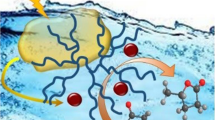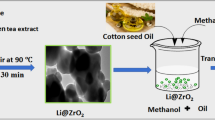Abstract
Ru–Ni/NaY catalyst modified by ruthenium was prepared by impregnation method. The structure and performance of the catalyst were characterized using scanning electron microscopy, transmission electron microscopy, low temperature N2 adsorption/desorption and X-ray diffraction, it was found that Ru–Ni/NaY catalyst has the advantages of small average particle size, uniform distribution and high dispersion. By controlling the current density at a sodium formate concentration of 0.5 mol/L to determine the activation effect of the catalyst, high catalytic activity and low hydrogenation reaction process can be achieved. When the concentration of sodium formate was 0.5 mol/L, the preactivation stirring speed was 300 r/min, the temperature was 75 °C, the preactivation time was 90 min, and the current was 200 mA, the catalyst is used in the conjugation reaction cycle. The bimetal Ru–Ni/NaY catalyst can be recycled for five times. The electrochemical activation of Ru–Ni/NaY catalyst and conventional activation was applied to the isomerization reaction of grape seed oil, respectively. Through the analysis of fatty acid composition of the product, the SCLA isomerization degree of Ru–Ni/NaY catalyst was 87.5%, SHP was 8.6%. And the main conjugated linoleic acids were c9, t11-CLA and t11-CLA, with the contents of 20.53% and 15.49%, respectively. The results demonstrate that electrochemical activation improves the isomerization selectivity of Ru–Ni/NaY catalyst and reduces the hydrogenation selectivity.











Similar content being viewed by others
References
M.A. Belury, A. Mahon, S. Banni, The conjugated linoleic acid (CLA) isomer, t10c12-CLA, is inversely associated with changes in body weight and serum leptin in subjects with type 2 diabetes mellitus. J. Nutr. 133(1), 257S–260S (2003). https://doi.org/10.1038/sj.ijo.0802160
A. Bernas, N. Kumar, P. Laukkanen, J. Väyrynen, T. Salmi, D.Y. Murzin, Influence of ruthenium precursor on catalytic activity of Ru/Al2O3 catalyst in selective isomerization of linoleic acid to cis-9, trans-11-and trans-10, cis-12-conjugated linoleic acid. Appl. Catal. A 267(1–2), 121–133 (2004). https://doi.org/10.1016/j.apcata.2004.02.032
A. Bernas, D.Y. Murzin, Influence of hydrogen preactivation on the linoleic acid isomerization properties of supported ruthenium catalyst. React. Kinet. Catal. Lett. 78(1), 3–10 (2003). https://doi.org/10.1023/A:1022553027885
A. Bernas, D.Y. Murzin, Linoleic acid isomerization on Ru/Al2O3 catalyst: 1: Conjugation and hydrogenation. Chem. Eng. J. 115(1–2), 13–22 (2005a). https://doi.org/10.1016/j.cej.2005.09.001
A. Bernas, D.Y. Murzin, Linoleic acid isomerization on Ru/Al2O3 catalyst: 2. Elementary step mechanism and data fitting. Chem. Eng. J. 115(1–2), 23–43 (2005b). https://doi.org/10.1016/j.cej.2005.08.013
M. Bijad, H. Karimi-Maleh, M. Farsi, S.-A. Shahidi, An electrochemical-amplified-platform based on the nanostructure voltammetric sensor for the determination of carmoisine in the presence of tartrazine in dried fruit and soft drink samples. J. Food Meas. Charact. 12(1), 634–640 (2017). https://doi.org/10.1007/s11694-017-9676-1
X. Cardó, O. Bergadà, Y. Cesteros, P. Salagre, Effect of catalyst acidity and porosity on the catalytic isomerization of linoleic acid to obtain conjugated linoleic acids (CLAs). Chem. Eng. J. 183, 459–465 (2012). https://doi.org/10.1016/j.cej.2011.12.088
J. Chen, L. Wang, P. Wang, J. Cai, Catalytic properties of barium modified Ru/MgZrO2 for the isomerization linoleic acid to conjugated linoleic acid. J. Ind. Eng. Chem. 80, 425–430 (2019). https://doi.org/10.1016/j.jiec.2019.08.022
T.G. Devi, M.P. Kannan, X-ray diffraction (XRD) studies on the chemical states of some metal species in cellulosic chars and the Ellingham diagrams. Energy Fuels 21(2), 596–601 (2007). https://doi.org/10.1021/ef060395t
H.C. Duong, M. Duke, S. Gray, B. Nelemans, L.D. Nghiem, Membrane distillation and membrane electrolysis of coal seam gas reverse osmosis brine for clean water extraction and NaOH production. Desalination 397, 108–115 (2016). https://doi.org/10.1016/j.desal.2016.06.024
L. Feng, Y. Shen, T. Wu et al., Adsorption equilibrium isotherms and thermodynamic analysis of CH4, CO2, CO, N2 and H2 on NaY Zeolite. Adsorption 26(11), 1101–1111 (2020). https://doi.org/10.1007/s10450-020-00205-8
L. Fernandes, S. Casal, R. Cruz, J.A. Pereira, E. Ramalhosa, Seed oils of ten traditional Portuguese grape varieties with interesting chemical and antioxidant properties. Food Res. Int. 50(1), 161–166 (2013). https://doi.org/10.1016/j.foodres.2012.09.039
D. Firestone, AOCS Official Methods and Recommended Practices of the AOCS (AOCS, Urbana, 2009)
S. Fulignati, C. Antonetti, D. Licursi, M. Pieraccioni, E. Wilbers, H.J. Heeres, A.M.R. Galletti, Insight into the hydrogenation of pure and crude HMF to furan diols using Ru/C as catalyst. Appl. Catal. A 578, 122–133 (2019). https://doi.org/10.1016/j.apcata.2019.04.007
P. Gogoi, A.S. Nagpure, P. Kandasamy, C.V.V. Satyanarayana, T. Raja, Insights into the catalytic activity of Ru/NaY catalysts for efficient H2 production through aqueous phase reforming. Sustain. Energy Fuels 4(2), 678–690 (2020). https://doi.org/10.1039/C9SE00797K
X. Guo, X. Wang, J. Guan, X. Chen, Z. Qin, X. Mu, M. Xian, Selective hydrogenation of D-glucose to D-sorbitol over Ru/ZSM-5 catalysts. Chin. J. Catal. 35(5), 733–740 (2014). https://doi.org/10.1016/S1872-2067(14)60077-2
B.E. Hayden, Particle size and support effects in electrocatalysis. Acc. Chem. Res. 46(8), 1858–1866 (2013). https://doi.org/10.1021/ar400001n
M.O. Jung, J.W. Ju, D.S. Choi, S.H. Yoon, M.Y. Jung, CLA formation in oils during hydrogenation process as affected by catalyst types, catalyst contents, hydrogen pressure, and oil species. J. Am. Oil Chem. Soc. 79(5), 501–510 (2002). https://doi.org/10.1007/s11746-002-0512-8
D. Kmac, E. Mly, F. Na et al., A novel detection method for organophosphorus insecticide fenamiphos: molecularly imprinted electrochemical sensor based on core-shell Co3O4 @MOF-74 nanocomposite. J. Colloid Interface Sci. 592, 174–185 (2021). https://doi.org/10.1016/j.jcis.2021.02.066
H. Li, Y. He, D. Shen, S. Cheng, J. Wang, H. Liu et al., Design an in-situ reduction of Ni/C–SiO2 catalyst and new insights into pretreatment effect for CH4–CO2 reforming reaction. Int. J. Hydrog. Energy 42(16), 10844–10853 (2017). https://doi.org/10.1016/j.ijhydene.2017.03.156
H. Li, Z. Li, D. Ji, G. Li, Hydrogenation of paranitrotoluene to p-methyl-cyclohexylamine catalyzed by PEG modified Ru/NaY catalysts. Catal. Commun. 104, 91–95 (2018). https://doi.org/10.1016/j.catcom.2017.10.027
S. Liu, Z. Wang, X. Xu, Y. Ding, Z. Guo, Production of conjugated linoleic acid-rich cottonseed oil by supported Ru catalyzed isomerization. Ind. Crops Prod. 97, 10–20 (2017). https://doi.org/10.1016/j.indcrop.2016.12.004
K. Malins, Synthesis of renewable hydrocarbons from vegetable oil feedstock by hydrotreatment over selective sulfur-free SiO2-Al2O3 supported monometallic Pd, Pt, Ru, Ni, Mo and bimetallic NiMo catalysts—ScienceDirect. Fuel 285, 119129 (2021). https://doi.org/10.1016/j.fuel.2020.119129
P. Mierczynski, B. Dawid, K. Chalupka, W. Maniukiewicz, I. Witonska, M.I. Szynkowska, Role of the activation process on catalytic properties of iron supported catalyst in Fischer–Tropsch synthesis. J. Energy Inst. 93(2), 565–580 (2020). https://doi.org/10.1016/j.joei.2019.06.008
Y. Orooji, M. Ghanbari, M. Salavati-Niasari, Facile fabrication of silver iodide/graphitic carbon nitride nanocomposites by notable photo-catalytic performance through sunlight and antimicrobial activity. J. Hazard. Mater. (2020). https://doi.org/10.1016/j.jhazmat.2020.122079
M.A. Paviotti, B.M. Faroldi, L.M. Cornaglia, Ni-based catalyst over rice husk-derived silica for the CO2 methanation reaction: effect of Ru addition. J. Environ. Chem. Eng. (2021). https://doi.org/10.1016/j.jece.2021.105173
A. Philippaerts, S. Goossens, P.A. Jacobs, B.F. Sels, Catalytic production of conjugated fatty acids and oils. ChemSusChem 4(6), 684–702 (2011). https://doi.org/10.1002/cssc.201100086
B. Rha, C. Srpb, D. Akb et al., Hierarchically structured ternary heterojunctions based on Ce 3+/Ce 4+ modified Fe3O4 nanoparticles anchored onto graphene oxide sheets as magnetic visible-light-active photocatalysts for decontamination of oxytetracycline. J. Hazard. Mater. 376, 200–211 (2019). https://doi.org/10.1016/j.jhazmat.2019.05.035
M. Silva, B. Zisu, J. Chandrapala, Interfacial and emulsification properties of sono-emulsified grape seed oil emulsions stabilized with milk proteins. Food Chem. 309, 125758 (2020). https://doi.org/10.1016/j.foodchem.2019.125758
H. Veisi, A. Nikseresht, S. Mohammadi, S. Hemmati, Facile in-situ synthesis and deposition of monodisperse palladium nanoparticles on polydopamine-functionalized silica gel as a heterogeneous and recyclable nanocatalyst for aerobic oxidation of alcohols. Chin. J. Catal. 39(6), 1044–1050 (2018). https://doi.org/10.1016/S1872-2067(18)63049-9
T. Wang, X. Zhang, H. Wang, T. Yuan, D. Yu, L. Wang, L. Jiang, Study on the electrochemical hydrogenation of soybean oil under H2 conditions. J. Oleo Sci. 68(4), 311–320 (2019). https://doi.org/10.5650/jos.ess18233
Y. Xiao, J. Shang, M. Zhai et al., Hydrodeoxygenation of fatty acid methyl esters and simultaneous products isomerization over bimetallic Ni‐Co/SAPO‐11 catalysts. Int. J. Energy Res. (2021). https://doi.org/10.1002/er.6391
J.L. Xie, F.F. Chi, F.L. Meng, A.R. Peng, Application of iron powder reduction method to remove heavy metals in waste pickling acid. Mater. Sci. Forum 980, 377–386 (2020). https://doi.org/10.4028/www.scientific.net/MSF.980.377
D. Yu, T. Li, J. Chen, C. Yu, N. Wu, T. Liu, L. Wang, Ni-Ag bimetallic magnetic catalyst improves the performance of the catalytic transfer hydrogenated soybean oil. J. Oleo Sci. (2019). https://doi.org/10.5650/jos.ess18260
X. Zhang, F. Zhang, R.-F. Guan, K.-Y. Chan, Preparation of Pt-Ru-Ni ternary nanoparticles by microemulsion and electrocatalytic activity for methanol oxidation. Mater. Res. Bull. 42(2), 327–333 (2007). https://doi.org/10.1016/j.materresbull.2006.05.021
D. Zhao, Q. Huo, J. Feng, B.F. Chmelka, G.D. Stucky, Nonionic triblock and star diblock copolymer and oligomeric surfactant syntheses of highly ordered, hydrothermally stable, mesoporous silica structures. J. Am. Chem. Soc. 120(24), 6024–6036 (1998). https://doi.org/10.1021/ja506344k
Acknowledgements
This work was supported by a grant from the Natural Science Foundation of Heilongjiang Province: Mechanism of enzymatic degumming process of soybean oil characterized by electrochemical biosensor (No.: LH2020C061).
Funding
Funding was provided by Mechanism of enzymatic degumming process of soybean oil characterized by electrochemical biosensor (Grant No. LH2020C061).
Author information
Authors and Affiliations
Corresponding authors
Additional information
Publisher's Note
Springer Nature remains neutral with regard to jurisdictional claims in published maps and institutional affiliations.
Rights and permissions
About this article
Cite this article
Luo, S., Yao, J., Wang, R. et al. Effect of nickel modification on Ru–Ni/NaY catalyst structure and linoleic acid isomerization selectivity. Food Measure 15, 5584–5598 (2021). https://doi.org/10.1007/s11694-021-01101-7
Received:
Accepted:
Published:
Issue Date:
DOI: https://doi.org/10.1007/s11694-021-01101-7




